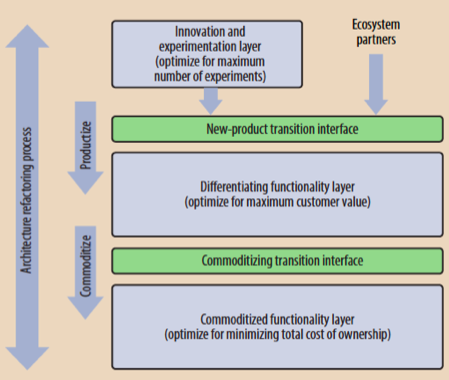 Every company is part of an business ecosystem. In the ecosystem, we find the partners, the suppliers, the customers, competitors, complementors as well as other stakeholders. A business ecosystem was more formally defined in the early 1990s by Moore as an economic community with three key characteristics. First, there is a symbiotic relationship between the members of the community and the survival of these members implies survival of ecosystem.
Every company is part of an business ecosystem. In the ecosystem, we find the partners, the suppliers, the customers, competitors, complementors as well as other stakeholders. A business ecosystem was more formally defined in the early 1990s by Moore as an economic community with three key characteristics. First, there is a symbiotic relationship between the members of the community and the survival of these members implies survival of ecosystem.
Second, there is co-evolution meaning that partners co-evolve capabilities around new innovations. Third, the ecosystem is organized around a platform that is defined as tools, services, and technologies that members of the ecosystem can use to enhance their own performance. The basic notion of a business ecosystem (and a software ecosystem is a special type of business ecosystem) is that everyone is better off within the ecosystem than outside of it.
As is clear from the description of a business ecosystem, there are numerous virtuous, as well as competitive, dependencies between the ecosystem partners. It is these dependencies that allows the member of the ecosystem to be better off by being inside it. The backside of this, however, is that any changes need to be negotiated and agreed between ecosystem partners. And this easily slows down the evolution of the ecosystem and, if not managed properly, it can destroy the competitiveness of the entire ecosystem and risk its disruption by other companies and ecosystems.
Within the ecosystem of a company there are customers – the people that provide you with the revenue to stay, and preferably thrive, in business. The challenge is that in several of the cases where I have been involved, the challenge is that the most important customers are the ones least interested in changing and evolving the engagement model. Why this happens can easily be understood using the Three Layer Product Model that I shared in an earlier blog post (see image below). Even though the functionality and value that you provide for your customers is differentiating for you, it typically is considered commodity by your customers. If your customers viewed it as differentiating, often they would be more interested in having more control of the functionality; for instance, by managing it in-house. As it is commodity for them, there is little incentive to evolve as the it will bring with it cost but very little value. Hence, the tendency is to delay making changes.

Figure: The Three-Layer Product Model (3LPM)
The risk is of course that this presents a possible source of disruption for your company: as your customers are reluctant to change, you don’t change and as a consequence you may get left behind and disrupted by the competition. This challenge is often exacerbated by product managers and others who wait for customers to ask for changes before prioritizing the work items needed to evolve and innovate. The key challenge, however, is that your customers can and often will slow you down and hurt your competitiveness.
Addressing this challenge is difficult and requires a culture in the company that identifies the importance of being ahead of the customer. There are three mechanisms that I have found helpful in avoiding this situation, i.e. analysing customer requests, horizon-based resource allocation and working with fringe customers. I’ll describe each of these mechanisms in a bit more detail below.
First, one of the rules that I often use with the companies that I work with is: if your customer has to ask you for some functionality, you have already failed. Your inability to predict customer needs before the customer is able to verbalize the need and is ready to ask for it is a critical failure that needs to be carefully analyzed. This is not to say that every customer request should be honored! Rather that each request should be analyzed from the preemptive perspective of predicting customer needs before customers ask for it. This analysis can then be used to analyze whether there are any current topics that are not being prioritized but are likely to become future customer requests. This can then be used to preempt and prioritize work.
Second, in another blog post I introduced the three horizon model where resource allocation is divided over three horizons of work (see here). Ensuring that 10% of resources are allocated for building new differentiation and preferably with other customers or engagement models than the ones slowing you down provides at least some hedge against key customers that are slowing you down.
Third, as Clayton Christensen analyzed to nicely in his book on the innovator’s dilemma, most companies have a tendency to focus on the most profitable and typically most demanding customers. From a short term revenue generation perspective, this is entirely the correct strategy, but from a long-term perspective this tends to cause you to sacrifice more and more of the rest of the market to competitors. To avoid this, it is important to work with fringe customers using the new, innovative engagement models. This allows the company to innovate with less critical customers and it builds confidence within the company as well as with its key customers that the innovations are actually providing the expected business value.
Concluding, if not managed properly your most important customers are likely to be the ones that slow your rate of innovation down to the point that your innovativeness is negatively affected and you may risk disruption. Business ecosystems are wonderful when they work, but these can also be anchors that slow you down and increase the risk of disruption. To avoid this, I have worked with three mechanisms to avoid this, i.e. analyzing customer requests, horizon-based resource allocation and working with fringe customers. In short, enjoy your business ecosystem, but be vigilant against the risks!